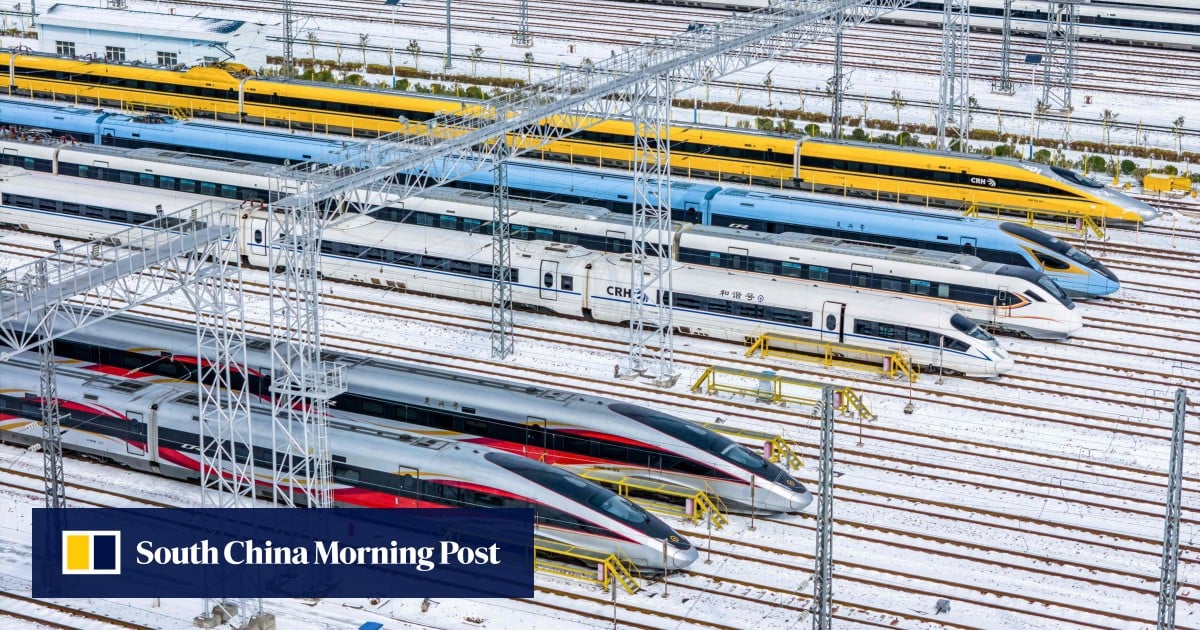They propose using high-sensitivity sensing technology – which is also better suited for extreme conditions – to paint a complete and continuous picture with every turn of a train’s wheel.
Feng and his team developed a giant ring-shaped sensor that is as thin as a piece of paper and adheres perfectly to the inner or outer walls of the train’s wheels, according to a peer-reviewed paper published in January by the journal Scientia Sinica Technologica.
This flexible sensor is capable of not only measuring previously overlooked wheel deformations but can also help engineers pinpoint minute flaws in the tracks with unprecedented precision, nipping risks in the bud, the researchers said.
The team said the sensor also addresses a long-standing issue for the high-speed rail industry, which is the potential for single-point sensors to “twist” the data when the trains navigate curved tracks.
China operates the most complex high-speed railway network in the world and has a safety record that surpasses the commercial airline industry, with no passenger fatalities caused by accidents in the past decade.
Next year, a new generation of high-speed trains will be rolled out across the country’s sprawling network – longer than the equator – with maximum speeds increasing from the current 350km/hr (217mph) to 400km/hr (249mph).
“Confronting such a sprawling high-speed rail network, ensuring train safety and trimming maintenance costs are the linchpins in the realm of railway transport,” Feng and his colleagues wrote.
“When paired with wireless sensing technology, our flexible wheel-rail force sensors can keep a real-time, continuous pulse on high-speed train wheel-rail forces. This is a game-changer for the next generation of high-speed rail in China.”
Feng also leads a project funded by the National Natural Science Foundation of China involving sensors for near-space hypersonic vehicles that can rip through the sky more than seven times faster than the speed of sound at high altitude.
The extreme temperatures and pressure during hypersonic flight can deform the craft, a phenomenon that Feng’s team is focused on preventing, zeroing in on the failure mechanisms of solid materials and structures in these unconventional environments.
The hypersonic team’s studies require some gruelling tests, pushing the researchers to craft sensors that are flexible, expandable, and able to perform in the harshest environments.
While China has invested significant resources in the development of hypersonic vehicles, these cutting-edge technologies have remained largely confined to military applications.
However, an increasing number of scientists and engineers involved in China’s hypersonic research believe that these advances will gradually trickle down into civilian applications and take the Chinese manufacturing industry to new heights.
They also anticipate that civilian applications of the technologies will, in turn, fuel further weaponry research and production.
The enormous scale and complexity of the high-speed rail super infrastructure in China have already turned it into a testing ground for new technologies.
For instance, Chinese quantum physicists are developing highly secure quantum communication networks for the network. Artificial intelligence has also been applied to optimise operational efficiency and detect foreign objects on tracks.
Chinese scientists hope to smooth the path of new 400km/h bullet trains
Chinese scientists hope to smooth the path of new 400km/h bullet trains
The latest generation of 5G technology is also giving high-speed train drivers superhero-like vision, allowing them to receive real-time images beyond their line of sight.
Meanwhile, hypersonic wind tunnels are aiding in the development of futuristic low-vacuum tube magnetic levitation high-speed trains that could reach speeds of 1,000km/hr (621mph) or beyond.
When designing large-area sensors suitable for high-speed train wheels, Feng’s team encountered several obstacles, especially the need to balance low-cost, large-scale manufacturing capability with superior performance.
According to the paper, the researchers repurposed commonly available silicon wafers – the backbone of chip manufacturing – as the foundation for the sensors. These were coated with a thin veneer of gold.
While gold is pricey, the team kept the expense manageable, using it at a minute thickness for each wafer – barely a fraction of a hair’s breadth, which was etched with intricate sensor patterns, using standard photolithography equipment.
These microscopic structures, known as strain gratings, are comprised of multiple layers of compounds and metals which exhibit changes in their electrical resistance when subjected to variations in pressure.
When an electrical current passes through these layers, their response generates signals that indicate any deformations in the wheel’s action, according to the paper.
“Our vertical loading experiments reveal that the flexible ring sensor exhibits not only strong linearity but also remarkable stability and repeatability under cyclic loading conditions,” the researchers wrote.
Feng and his team said that in real-world applications, the sensor could be combined with low-noise wireless telemetry technology to send wheel-rail force signals to a data analysis terminal.




